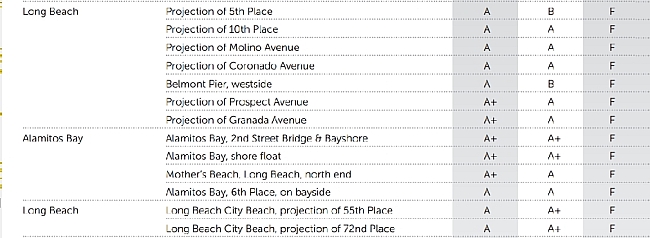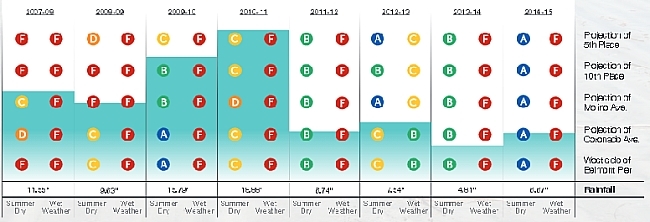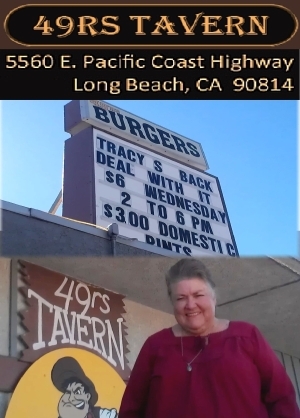  |
Below is Heal the Bay's Beach Report text re Long Beach:
[Heal the Bay text] During dry weather, the City of Long Beach continues to show improved beach water quality. This past year, summer dry weather A grades were a perfect 100% (15 sites), besting the five-year average by 16% (71% A or B grades). Winter dry weather grades also maintained near perfection as well, with 100% of locations earning A or B grades: 13 As and 2 Bs...However, no other geographic location presented such a stark dichotomy between dry weather and wet weather grades than in Long Beach. Whereas 100% of the monitored locations received A grades in summer dry weather, the opposite was true for wet weather, with 100% of them receiving F grades. Not one monitored location was safe for swimming when there was a storm event. The location of Long Beach, situated between two of the largest rivers (Los Angeles and San Gabriel River) in Los Angeles County, likely contributes greatly to these problematic wet weather grades.
To see the progress Long Beach has made over time, see the Heal the Bay graphic (below) showing LB's annual grades from 2007-08 as well as annual rainfall.

Below is the City of Long Beach "e-notify" message, alongside LBREPORT.com's comments and local details.
| City of LB e-notify | LBREPORT.com comments |
|---|---|
| The City of Long Beach received 100 percent "A" grades for water quality, including seven (7) "A+" grades, according to the Heal the Bay 2015 Annual Beach Report Card that was issued today. | Inaccurate. Straight A's during summer dry months but two B's (5th Place, Belmont Pier) in winter dry periods...and straight F's during wet weather year round. |
| "Our water quality continues to show big improvements thanks to our investments in technology and infrastructure improvements," said Mayor Robert Garcia. | Accurate, but Heal the Bay points out that this year's grades are generally higher overall primarily as a result of the drought (less runoff.) |
| "We also need to thank our neighboring cities who have worked closely with us to keep the Los Angeles and San Gabriel Rivers clean." | Contradicted by the facts. The two rivers are not clean and LB's Mayor needs to tell the truth (to apply continued pressure to clean the rivers.) Heal the Bay's report explicitly notes that LB's location between the two rivers likely "contributes greatly" to its F wet weather grades. That invites the conclusion that the two rivers send Long Beach filth from upriver neighboring cities that needs to be addressed. |
| Fifteen of the 15 beaches sampled received "A" grades during the state-mandated testing period from April through October, known as AB 411, the Assembly Bill that mandates water quality testing. Long Beach also received nearly 100 percent "A+" and "A" grades, with only two "B" grades, during the winter dry months. | Accurate, but the City's Environmental Health Division now monitors 15 locations, which is down from 25 historically monitored on a weekly basis. |
| "Our namesake beaches are one of our most important assets, so I'm very pleased to see that several years of investments into diverting urban run-off from our recreational areas is making a difference in our beach water quality," said Vice-Mayor Suja Lowenthal, who represents the 2nd District. | Accurate |
| The Colorado Lagoon and the other beaches in Alamitos Bay all received five "A+" grades with one "A" grade during the state-mandated testing period from April through October. The Colorado Lagoon and Alamitos Bay continue to be sites for investment and improvements to water quality and this has consistently reaped dividends for the City. | Accurate |
| "Many local and regional initiatives have helped improve our beaches greatly and we are proud of our perfect 100 percent 'A' grades during the summer dry weather," noted Councilmember Suzie Price, who represents the 3rd District. | Accurate |
| Last year, the Heal the Bay Annual Beach Report Card gave 13 of the 15 beaches sampled "A" or "B" grades. This year, the report noted, Long Beach bested the five-year average by 16% (71% A or B grades). | Accurate |
| Rainy weather remains a challenge for the City of Long Beach, with the Los Angeles and San Gabriel Rivers discharging pollutants into coastal waters. | Accurate but euphemized. The truth is straight F's in wet weather. We doubt many people swim in the ocean during wet weather, but it's important to note (as Heal the Bay does) that "no other geographic location presented such a stark dichotomy between dry weather and wet weather grades than in Long Beach." |
| Here are some examples of how the City of Long Beach has used infrastructure improvements, grant funding, regional partnerships and technology to improve water quality in Long Beach:
| Part of the history is omitted. Taxpaying residents had to wage legal battles, engage in years of political and policy advocacy and at some points had to sue to bring improvements.
Of course all of this required a significant investment of public resources (state, county and city), but much of it was spurred by the efforts of local residents and advocacy groups who raised awareness and offered constructive alternatives. In our view, those residents and groups deserve much of the credit. |
And LBREPORT.com consistently points out, Heal the Bay's grades, while useful, are based on organic materials in the water (E. coli, and Enterococcus bacteria, basically fecal indicators from people, animals, sewage leaks, etc.) The group's grades don't reflect chemicals and/or industrial products that may or may not be in area waters.
[Scroll down for further.]
Advertisement | Advertisement |
[Scroll down for further.]
Advertisement | Advertisement |
Advertisement  | Advertisement |
blog comments powered by Disqus
Recommend LBREPORT.com to your Facebook friends:
Follow LBReport.com with:
RSS |
Contact us: mail@LBReport.com








Hardwood Floor Specialists
Call (562) 422-2800 or (714) 836-7050
